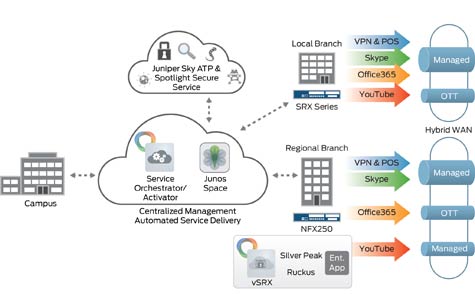The days when IT organizations had to manually provision every network service consumed by a branch office are finally, and mercifully, coming to a close. This week, Juniper Networks unfurled a cloud-based approach to software-defined networking (SDN) that enables IT organizations to centrally manage the provisioning of networking services to branch offices without having to physically dispatch a technician.
The Juniper Networks Cloud-Enabled Branch offering gives IT organizations the option of deploying those services on network equipment from Juniper Networks that is locally installed or route all network services through a central data center.
In either case, Jennifer Blatnik, vice president of cloud, enterprise and security portfolio marketing, says Juniper Networks is making use of its Contrail Service Orchestration service to automate the delivery of network services to a branch office using the cloud. In effect, Blatnik says a branch office can now be a natural extension of a network fabric spanning the entire enterprise.
In addition to providing a built-in software-defined wide area networking (SD-WAN) capability, Juniper Networks expects IT organizations to use this approach to deliver a broad range of Network Functions Virtualization (NFV) software to those branch offices. Regardless of where those NFVs are actually deployed, the goal is to eliminate many of the physical appliances that are today required to securely deliver network services to a branch office.
It may have taken a while, but advances in SDN platforms are now coming at a much faster rate. Either using pre-defined templates or lower-level application programming interfaces (APIs), the amount of control IT organizations will soon have over network services is unprecedented. It may still take longer for SDNs to fully wind their way through the networking ecosystem. But the days when each piece of network gear had to be individually configured using command line interfaces (CLIs) will soon be a distant memory from some bygone era.




